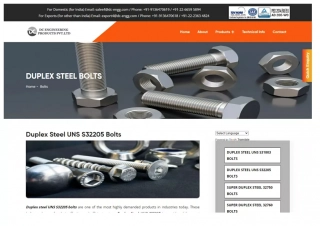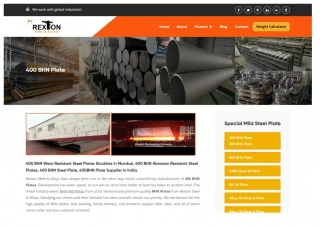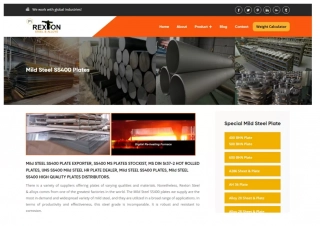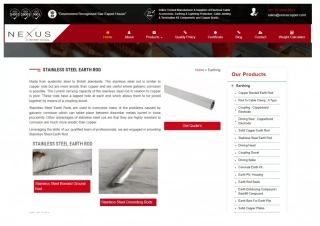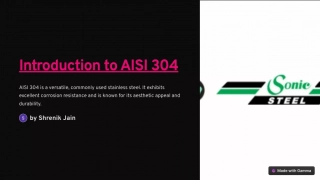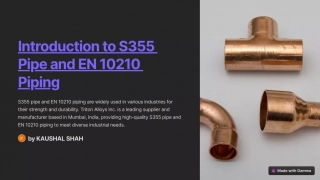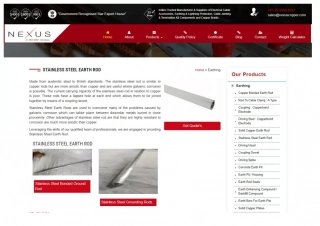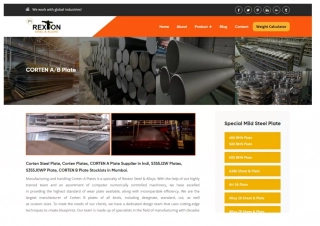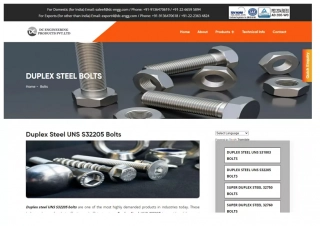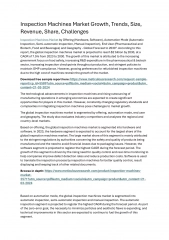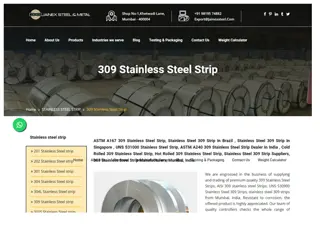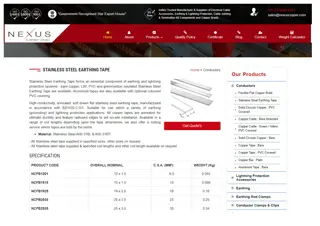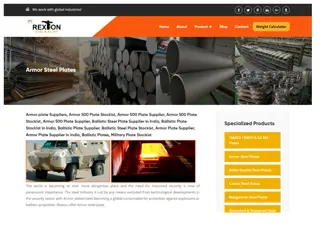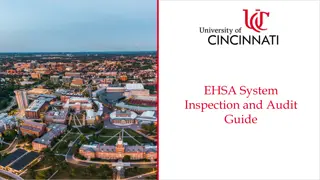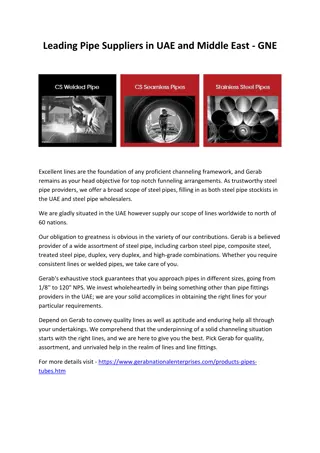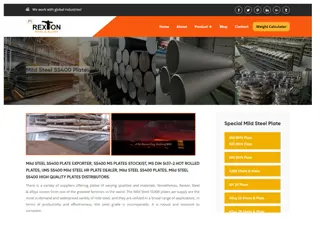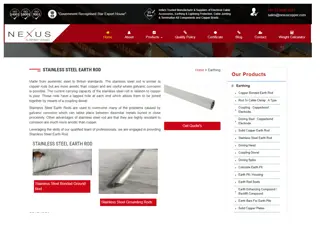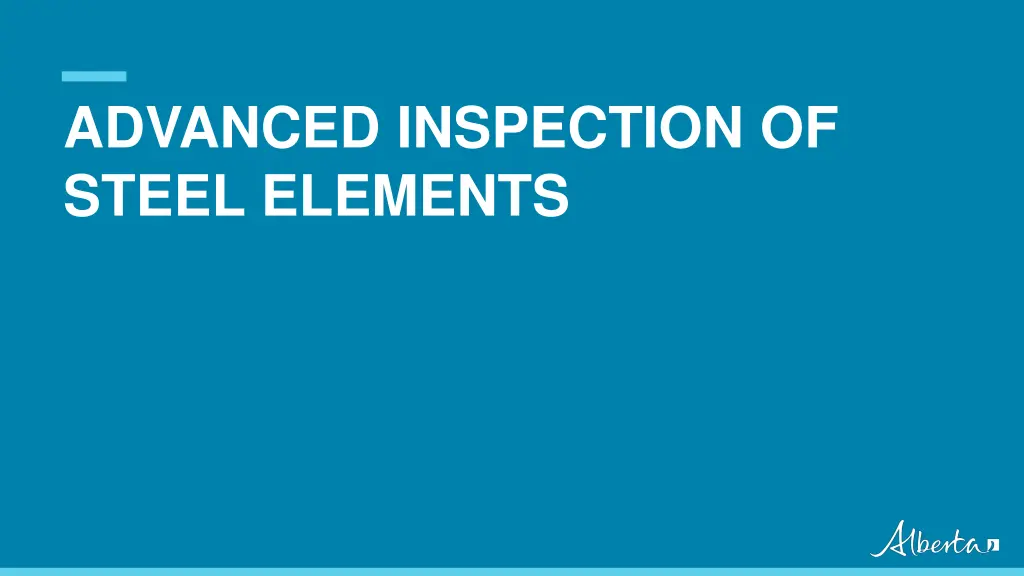
Advanced Inspection Techniques for Steel Elements
Explore advanced non-destructive testing methods like dye penetrant inspection and magnetic particle inspection for steel elements. Learn how these techniques help detect and define faults effectively, ensuring structural integrity and safety.
Download Presentation

Please find below an Image/Link to download the presentation.
The content on the website is provided AS IS for your information and personal use only. It may not be sold, licensed, or shared on other websites without obtaining consent from the author. If you encounter any issues during the download, it is possible that the publisher has removed the file from their server.
You are allowed to download the files provided on this website for personal or commercial use, subject to the condition that they are used lawfully. All files are the property of their respective owners.
The content on the website is provided AS IS for your information and personal use only. It may not be sold, licensed, or shared on other websites without obtaining consent from the author.
E N D
Presentation Transcript
ADVANCED INSPECTION OF STEEL ELEMENTS
Methods of Inspection Level II inspection in steel elements is made if cracks or potential for cracks or faults is present Visual Important for detecting degradation Logical and systematic procedures Used to establish non-destructive testing (NDT) techniques 2
Methods of Inspection Non-Destructive Testing To supplement visual inspection To define the extent of faults 3
Non-Destructive Test Methods Dye Penetrant Inspection Surface requires mechanical cleaning Low viscosity, high capillary fluid containing red dye is sprayed and allowed to penetrate the cracks and surface defects Excess fluid is wiped from the surface after a penetration time Surface sprayed with a developer Cracks and faults will be apparent by drawn red dye on a surrounding white background 4
Non-Destructive Test Methods Dye Penetrant Inspection Advantages: Low cost, requires minimal skills, portable, not time consuming, can identify extent of surface cracks Disadvantages: Limited to surface defects 5
Non-Destructive Test Methods Magnetic Particle Inspection Yoke is used to produce a magnetic field in the steel Fine iron powder is sprayed on the surface Field is distorted by surface or near surface discontinuities causing concentrations of magnetic lines Iron powder is drawn to these lines 6
Non-Destructive Test Methods Magnetic Particle Inspection Advantages: portable, requires minimal skills and can define tight cracks Disadvantages: limited to the inspection of cracks and surface defects near the surface. Depth of cracks cannot be determined and element may become magnetized 7
Non-Destructive Test Methods Hardness Testing Used to determine if mechanical properties have changed. System can be used for determining degradation after fire damage Telebrineller system principle is comparing hardness of a known test bar to the bridge element hardness Equipment: Anvil, steel impression bar, microscope, hammer 8
Non-Destructive Test Methods Hardness Testing Anvil is placed on the element and struck. Impact is transmitted to the test bar and the specimen element Steel ball makes an impression in the test bar and the element Diameters are measured and read through a microscope to within 0.05 mm 9
Non-Destructive Test Methods Hardness Testing 2 ( ) Dia of Impression In Bar Dia of Impression In Metal x BHN of Test Bar = BHN of Specimen Material BHN has a correlation to the tensile strength of steel Advantages: equipment is light weight, portable, reasonably accurate and requires no special training 10
Non-Destructive Test Methods Eddy Current Similar to MPI, except defect is detected by disturbances in electrical field Technique involves the use of a coil carrying an alternating current, which produces an eddy current in the part being examined Eddy current creates an impedance in the exiting coil Impedance depends on the nature of the part being tested and the exiting coil, magnitude and frequency of the current and the presence of discontinuities in the part Change is read from a meter 11
Non-Destructive Test Methods Eddy Current Advantages: size and depth of defects can be estimated reasonably and surface conditions such as paint do not affect scanning Disadvantages: changes in geometry affect the impedance and recalibration is required Limited use but has potential 12
Non-Destructive Test Methods Radiography Used to detect macroscopic defects and discontinuities Testing is based on the ability of radiation such as gamma rays to penetrate metal and other opaque materials to produce an image on sensitive film Gamma rays are produced by the disintegration of radioisotopes or radium of which cobalt or iridium are common sources 13
Non-Destructive Test Methods Radiography Source housed in a lead capsule to avoid radiation danger when not in use Amount of radiation getting through section being tested depends on section and density Defects result in less steel to pass through and more radiation gets on to the film placed behind the section Defect size and shape shows up as a dark area on the film 14
Non-Destructive Test Methods Radiography Planar defects are only detectable if they are parallel to the source axis due to radiation absorption Accuracy is dependent on the section and location of the crack Fatigue cracks to 2% of thickness can be detected 15
Non-Destructive Test Methods Radiography Advantages: permanent record and size and shape are determined Disadvantages: cannot detect planar defects and depth of cracks, hazardous and government licensing is required 16
Non-Destructive Test Methods Ultrasonics Uses high frequency sound waves to detect flaws Discontinuities act as a reflector for high frequency vibrations Sound waves are produced by a wave generator and receiving pulses are displayed on a cathode ray oscilloscope Ultrasonic frequency is 2 MHz or approximately 9500 ft/sec. 17
Non-Destructive Test Methods Ultrasonics Sound waves are transmitted by contact through a crystal and an intervening couplant Depth, size and nature of the defects are determined from the return signal on the oscilloscope Signal corresponds to elapsed time between transmission and reception 18
Non-Destructive Test Methods Ultrasonics Time can be converted to distance because the angle and velocity are known Sensitivity is influenced by the sound frequency, design of the unit, instrumentation processing of the return signal on the oscilloscope and operator skill 19
Non-Destructive Test Methods Ultrasonics Advantages: portability, sensitivity, ability to detect locations and depth of defects Disadvantages: influenced by operator ability, no permanent record of the display and it can be too sensitive displaying very minor defects 20
Non-Destructive Test Methods Sound reflection from fatigue crack at toe weld. Sound reflection from rollover in fillet weld. 21
Methods of Inspection It is important for the inspector to evaluate the damage and recognize the potential faults The visual assessment can be used to establish non-destructive testing (NDT) techniques to supplement the visual inspection and define the extent of faults or damage Assess the significance of damage on the load carrying capacity 23

